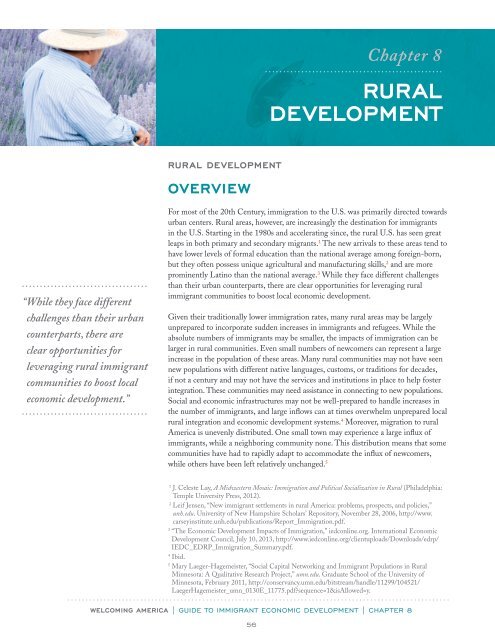Chapter 8RURALDEVELOPMENTRURAL DEVELOPMENTOverview“While they face differentchallenges than their urbancounterparts, there areclear opportunities forleveraging rural immigrantcommunities to boost localeconomic development.”For most of the 20th Century, immigration to the U.S. was primarily directed towardsurban centers. Rural areas, however, are increasingly the destination for immigrantsin the U.S. Starting in the 1980s and accelerating since, the rural U.S. has seen greatleaps in both primary and secondary migrants. 1 The new arrivals to these areas tend tohave lower levels of formal education than the national average among foreign-born,but they often possess unique agricultural and manufacturing skills, 2 and are moreprominently Latino than the national average. 3 While they face different challengesthan their urban counterparts, there are clear opportunities for leveraging ruralimmigrant communities to boost local economic development.Given their traditionally lower immigration rates, many rural areas may be largelyunprepared to incorporate sudden increases in immigrants and refugees. While theabsolute numbers of immigrants may be smaller, the impacts of immigration can belarger in rural communities. Even small numbers of newcomers can represent a largeincrease in the population of these areas. Many rural communities may not have seennew populations with different native languages, customs, or traditions for decades,if not a century and may not have the services and institutions in place to help fosterintegration. These communities may need assistance in connecting to new populations.Social and economic infrastructures may not be well-prepared to handle increases inthe number of immigrants, and large inflows can at times overwhelm unprepared localrural integration and economic development systems. 4 Moreover, migration to ruralAmerica is unevenly distributed. One small town may experience a large influx ofimmigrants, while a neighboring community none. This distribution means that somecommunities have had to rapidly adapt to accommodate the influx of newcomers,while others have been left relatively unchanged. 51J. Celeste Lay, A Midwestern Mosaic: Immigration and Political Socialization in Rural (Philadelphia:Temple University Press, 2012).2Leif Jensen, “New immigrant settlements in rural America: problems, prospects, and policies,”unh.edu. University of New Hampshire Scholars’ Repository, November 28, 2006, http://www.carseyinstitute.unh.edu/publications/Report_Immigration.pdf.3“The Economic Development Impacts of Immigration,” iedconline.org. International EconomicDevelopment Council, July 10, 2013, http://www.iedconline.org/clientuploads/Downloads/edrp/IEDC_EDRP_Immigration_Summary.pdf.4Ibid.5Mary Laeger-Hagemeister, “Social Capital Networking and Immigrant Populations in RuralMinnesota: A Qualitative Research Project,” umn.edu. Graduate School of the University ofMinnesota, February 2011, http://conservancy.umn.edu/bitstream/handle/11299/104521/LaegerHagemeister_umn_0130E_11775.pdf?sequence=1&isAllowed=y.WELCOMING AMERICA | GUIDE TO <strong>IMMIGRANT</strong> ECONOMIC DEVELOPMENT | CHAPTER 85.6
RURAL DEVELOPMENTOpportunitiesAt the same time, most of rural America has been struggling with declining populations and flagging economies.The average age of U.S. farmers is now 57 years old, and younger generations have shown less interest in continuingthe businesses. 6 A lack of a stable agricultural workforce across the U.S. has limited the expansion of agriculturalbusinesses. 7 The agricultural industry, which is the main economicdriver in many rural communities, has long relied on immigrant andmigrant labor to fill their needs. 8Meat-processing plants and other food-processing industries haverelocated to rural America from their former locations in urban cores.These jobs have attracted large numbers of recently arrived Latinoimmigrants, as well as refugees from Somalia, Sudan, and Burma inrecent years, groups which tend to be lower-skilled (by traditional formaleducation measures) than other immigrant groups and face higherlevels of cultural and linguistic barriers. 9 Despite these barriers, thesenew rural migrants have helped to provide the workforce necessary tokeep agriculture a growing industry, as well as to keep food processingoperations in rural areas.Meat-processing plants and otherfood-processing industries haverelocated to rural America from theirformer locations in urban cores... andnew rural migrants have helped toprovide the workforce necessaryAn added benefit of immigrant workers settling in rural areas is that they often are the only answer to stabilizing decliningpopulations and reinvigorating flagging business districts in rural towns across the country. 10 In addition to providingmuch-needed customers (and tax base) to shrinking rural towns, immigrant communities can provide their ownbusiness enterprises that may not only cater to their ethnic communities, but also provide services to the community atlarge. Several rural communities have embraced new immigrant entrepreneurs as a solution to the crisis of retiring familyownedbusinesses that have been closing due to a lack of leadership succession,as rural children are drawn to cities and more populous metrosin their adult years.Fear of change in receiving communities is often a great challenge inthese new rural immigration gateways. Through collaboration andcommunity building, however, as well as a shared vision that immigrationcan help rural areas excel economically, these fears can beovercome. Engaging incumbent residents on their own immigrantheritage and experiences as the “other” can lead to mutual understandingand better chances for successful integration and economicdevelopment. 11In addition to providing much-neededcustomers (and tax base) to shrinkingrural towns, immigrant communitiescan provide their own businessenterprises that may not only caterto their ethnic communities, but alsoprovide services to the communityat large.6See Environmental Protection Agency, http://www.epa.gov/agriculture/ag101/demographics.html.7See United States Department of Agriculture, http://www.ers.usda.gov/amber-waves/2012-june/immigration-policy.aspx.8Migrant labor is used simply to mean labor, which moves from place to place. In an agricultural context this could movement couldcenter on changing growing and harvesting seasons based on weather and crops. Migrant labor may intend on returning to their homecountries, while immigrant is a permanent resident alien. Over time, many migrant laborers may become immigrants seeking to stay inthe community permanently. Neither term is used here in its formal legal sense.9K.M. Donato, C.M.Tolbert, C.M., A. Nucci, and Y. Kawano, “Recent immigration settlement in the nonmetropolitan United States:Evidence from internal census data,” Rural Sociology 72 (2007): 557-559.10Dennis Coates and T.H. Gindling, “Hispanic Growth, Higher Rural Incomes,” dailyyonder.com. The Daily Yonder, November 10,2014, http://www.dailyyonder.com/hispanic-growth-higher-rural-incomes/2013/02/12/5652.11Laeger-Hagemeister, “Social Capital Networking and Immigrant Populations in Rural Minnesota: A Qualitative Research Project.”WELCOMING AMERICA | GUIDE TO <strong>IMMIGRANT</strong> ECONOMIC DEVELOPMENT | CHAPTER 85.7


